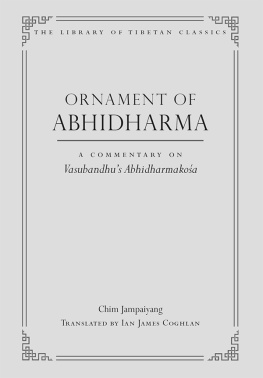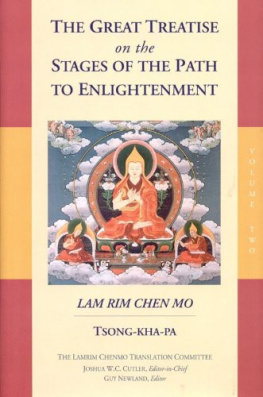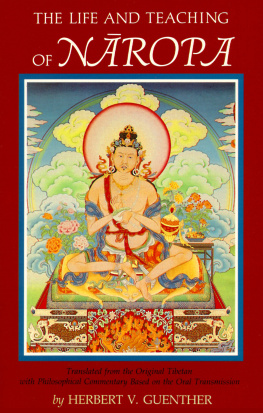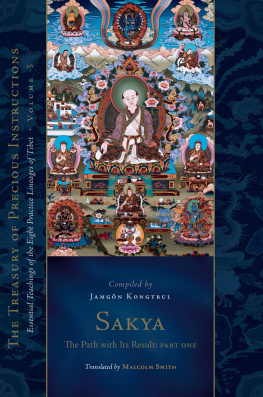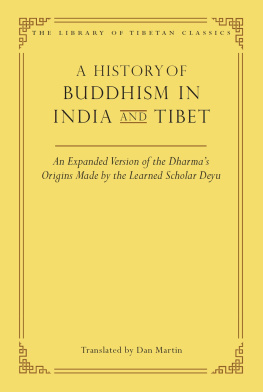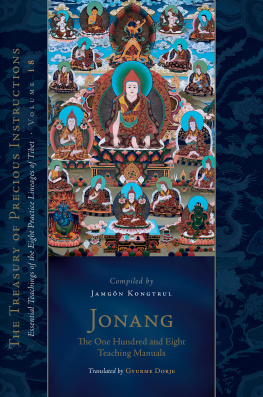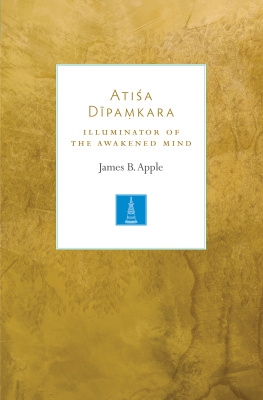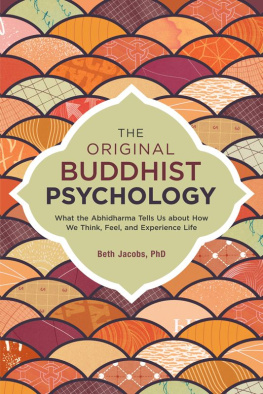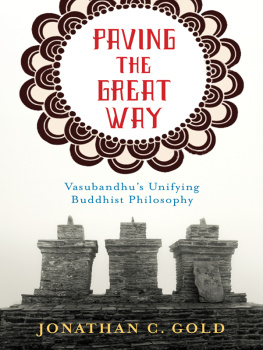The Library of Tibetan Classics is a special series being developed by the Institute of Tibetan Classics aimed at making key classical Tibetan texts part of the global literary and intellectual heritage. Eventually comprising thirty-two large volumes, the collection will contain over two hundred distinct texts by more than a hundred of the best-known authors. These texts have been selected in consultation with the preeminent lineage holders of all the schools and other senior Tibetan scholars to represent the Tibetan literary tradition as a whole. The works included in the series span more than a millennium and cover the vast expanse of classical Tibetan knowledge from the core teachings of the specific schools to such diverse fields as ethics, philosophy, linguistics, medicine, astronomy and astrology, folklore, and historiography.
Ornament of Abhidharma: A Commentary on Vasubandhus Abhidharmakoa
Chim Jampaiyang (ca. 12451325)
This lengthy work by a scholar of the Kadam school is the most authoritative Tibetan commentary on Vasubandhus Treasury of Abhidharma ( Abhidharmakoa ), a classic of Buddhist psychology and phenomenology. Chims Ornament of Abhidharma ( Mdzod grel mngon pai rgyan ) presents a detailed exposition of Vasubandhus text alongside a critical treatment of many of the texts central topics.
In terms of stature and authority, the Treasury of Abhidharma rivals Buddhaghosas contemporaneous Theravada classic, The Path of Purification , and deals with such central themes as the nature and causal dynamics of emotions, the typology of mind and mental factors, different heightened meditative states, and karma and its diverse manifestations. Vasubandhus work also covers the Buddhist theory of the evolution of both the cosmos and the life within.
Chims exposition of this important Buddhist classic is the greatest flowering of Abhidharma studies in Tibet. To this day this monumental work is used as a key textbook in the great monastic universities. It is a veritable encyclopedia, covering all areas of classical Indian Buddhist knowledge.

The single greatest Tibetan commentary on one of the most well-known and cited works of classical Indian Buddhism now presented for the first time in English.
________________________________________
This latest release from the estimable Library of Tibetan Classics presents one of the great works of Tibetan Buddhist scholarship: a thirteenth- century commentary by the Kadampa scholar Chim Jampaiyang on Vasubandhus classic Treasury of Abhidharma ( Abhidharmakoa ). Vasubandhus fifth-century work both summarized and critiqued contemporaneous Abhidharma doctrines, and Chims work continued this veritable tradition. Chim incorporates the perspectives of a broad range of both earlier and later Abhidharma and Mahyna traditions making this one of the great compendiums of Abhidharma scholasticism in the Buddhist world. This excellent translation will surely become a go-to source on such topics as the psychology of the afflictions, karma, cosmology, and the meditative practices leading to liberation. Moreover, Chims work well illustrates the robust rhetorical style of traditional Buddhist debate. The translator and editors have clearly laid out this interchange and sourced Chims extensive array of quotations. This is an impressive translation of an impressive work, a requisite for anyone interested in Abhidharma theory and practice, which remain remarkably alive and well to this day.
W ILLIAM S. W ALDRON , Middlebury College
Chim Jampaiyangs virtuoso commentary on Vasubandhus classic work provides an unmatched window into the intricate system of Abhidharma thought, as it was mastered and taught for centuries by Tibetan scholars. Ian James Coghlans adept translation of this influential, encyclopedic resource will be of great use to scholars and students, and represents a significant contribution to the study of Buddhist philosophy in English.
J ONATHAN C. G OLD , author of Paving the Great Way: Vasubandhus Unifying Buddhist Philosophy

Message from the Dalai Lama
T HE LAST TWO MILLENNIA witnessed a tremendous proliferation of cultural and literary development in Tibet, the Land of Snows. Moreover, due to the inestimable contributions made by Tibets early spiritual kings, numerous Tibetan translators, and many great Indian paitas over a period of so many centuries, the teachings of the Buddha and the scholastic tradition of ancient Indias Nland monastic university became firmly rooted in Tibet. As evidenced from the historical writings, this flowering of Buddhist tradition in the country brought about the fulfillment of the deep spiritual aspirations of countless sentient beings. In particular, it contributed to the inner peace and tranquility of the peoples of Tibet, Outer Mongolia a country historically suffused with Tibetan Buddhism and its culture the Tuva and Kalmuk regions in present-day Russia, the outer regions of mainland China, and the entire trans-Himalayan areas on the southern side, including Bhutan, Sikkim, Ladakh, Kinnaur, and Spiti. Today this tradition of Buddhism has the potential to make significant contributions to the welfare of the entire human family. I have no doubt that, when combined with the methods and insights of modern science, the Tibetan Buddhist cultural heritage and knowledge will help foster a more enlightened and compassionate human society, a humanity that is at peace with itself, with fellow sentient beings, and with the natural world at large.
It is for this reason I am delighted that the Institute of Tibetan Classics in Montreal, Canada, is compiling a thirty-two-volume series containing the works of many great Tibetan teachers, philosophers, scholars, and practitioners representing all major Tibetan schools and traditions. These important writings are being critically edited and annotated and then published in modern book format in a reference collection called The Library of Tibetan Classics , with their translations into other major languages to follow later. While expressing my heartfelt commendation for this noble project, I pray and hope that The Library of Tibetan Classics will not only make these important Tibetan treatises accessible to scholars of Tibetan studies, but will create a new opportunity for younger Tibetans to study and take interest in their own rich and profound culture. Through translations into other languages, it is my sincere hope that millions of fellow citizens of the wider human family will also be able to share in the joy of engaging with Tibets classical literary heritage, textual riches that have been such a great source of joy and inspiration to me personally for so long.

The Dalai Lama
The Buddhist monk Tenzin Gyatso

Special Acknowledgments
T HE I NSTITUTE OF T IBETAN Classics expresses its deep gratitude to the Ing Foundation for its generous support of the entire cost of translating this important volume. The Ing Foundations long-standing patronage of the Institute of Tibetan Classics has enabled the Institute to support the translation of multiple volumes from The Library of Tibetan Classics . We are deeply grateful to the foundation for offering us the opportunity to share many of the important texts of the Tibetan tradition with wider international readership, making these works truly part of the global literary, intellectual, and spiritual heritage.
Next page
